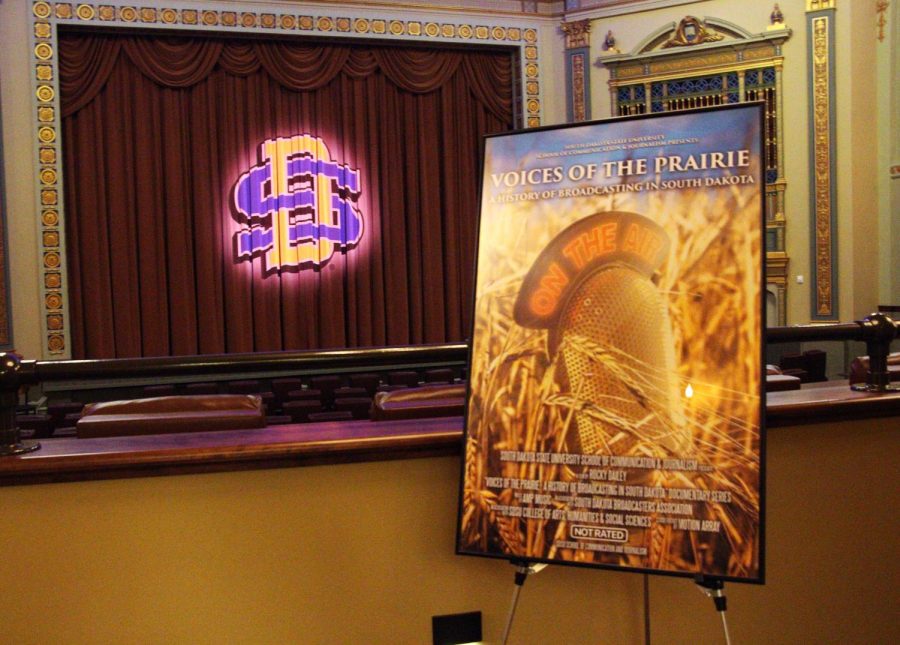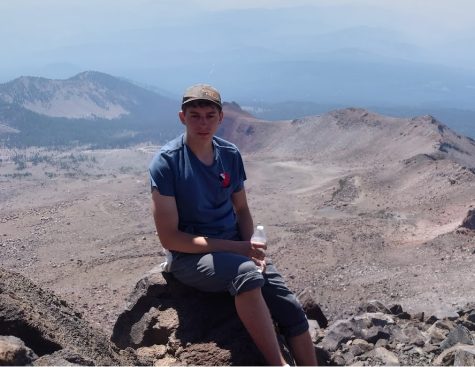COJO professor premieres broadcasting docuseries
Premiere of “Voices of the Prairie” documentary series at The STATE Theatre.
April 12, 2022
A South Dakota State University professor premiered the first episode of his new documentary series, “Voices of the Prairie: History of Broadcasting in South Dakota,” at The STATE Theatre in Sioux Falls Friday.
Rocky Dailey, an associate professor from the School of Communication and Journalism (COJO), is piecing together the history of television and radio broadcasting in the Midwest. According to a June 9, 2020, post on COJO’s Facebook page, Dailey received a $15,000 Research, Scholarship and Creative Activity Grant for his multi-episode project.
“We’re so grateful for SDSU’s commitment and support of faculty research, scholarship and creative activity,” COJO director Joshua Westwick said.
The first episode spanned about 20 minutes and focused on Verl Thomson. Thomson, born in 1906, was a radio pioneer in the Midwest at a time when some were hesitant to embrace the new technology.
“There was a lot of feeling that it was not God’s intent to send voices across the air,” Thomson said in the documentary as the audience chuckled.
Ginger Thomson, an instructor at SDSU and Verl Thomson’s daughter, shared stories of her father’s early years in radio in the documentary.
“[Verl Thomson’s high school physics] instructor let him experiment with the radio sets, and he would work on getting the … signal stronger when a wire crossed and blew up all the Bunsen burners,” Ginger said as the audience laughed along.
The documentary also featured interview footage Ginger had shot with her father 32 years ago as part of her master’s thesis, so Verl’s voice was present in the work.
Following a social hour for COJO faculty, alumni and friends and the premiere of the documentary, Dailey sat down for a Q&A.
Dailey told the attendees he was inspired to start the project after walking into Yeager Hall every day and passing the South Dakota Newspaper Hall of Fame.
“I was thinking, ‘Well, there’s got to be something like that for broadcasting,’” he said.
An audience member asked Dailey how many broadcasters he plans to focus on, but Dailey isn’t certain yet on who will be the focus of future episodes.
“I haven’t even touched TV yet,” Dailey responded. “I’m kind of limited to the stories that are out there and the people who can tell [them]. There’s a lot of good stories that I probably won’t get to tell because, frankly, too much time has gone by.”
Ginger is pleased with the work Dailey is doing to memorialize people like her father, but as Dailey pointed out during his Q&A, a lot of sources only come in contact by chance. When Ginger discovered the South Dakota Broadcasting Hall of Fame, once housed in Pugsley Hall, was not moved to Yeager Hall to accompany the Newspaper Hall of Fame, she called to see what she could do.
“I called the executive director, and I said, ‘I’m sorry, but if it weren’t for my dad … He was so instrumental in developing radio in this area,’” Ginger said. “[The executive director] said, ‘you know, we’re working with Dr. Dailey on a documentary about early broadcasters, so why don’t we get you two together?’ That’s how it happened.”
Dailey was assisted by Hannah Owens, a SDSU sophomore double majoring in interdisciplinary studies and Spanish. Owens attends interviews, transcribes audio and edits clips. She applied as a production assistant after talking to Dailey about wanting to make a historical documentary of her own for her Honors project.
“Something that can definitely get twisted is that the arts don’t have any research behind them or any science behind them, when really that’s not at all what happens,” Owens said. “Clearly, this is a huge historical piece and it’s something that had a lot of research go into it.”
David Bordewyck, executive director at the South Dakota Newspaper Association, praised Dailey’s work in sharing Verl’s “inspirational” story on the ground floor of the industry. As the journalism field continues to evolve, Bordewyck said he will be asking himself, “who is the next Verl Thomson?”
Frank Robertson, an instructor from COJO, also attended the premiere. He described Dailey’s production in three words: fantastic; informative; beautiful.
“It was fascinating to correlate that to modern day times in my generation, the older generation and the dawn of the internet and what that was going to mean and how that was going to be used,” Robertson said.
Dailey said: “I think everyone in this room has lived through social media and streaming, and to try to think about, like in Verl’s case, where you’re basically teaching yourself and putting things together is kind of exciting. There was really no precedent and they just kind of paved the way.”






















